Smoky Mountains Fall Travel Guide
Experience the best that Smoky Mountains National Park has to offer during the fall including where to see the colors, best hikes, and more!

Spanning over 500,000 acres in eastern Tennessee and western North Carolina, Great Smoky Mountains National Park is a mecca for fall foliage. Attracting visitors from all over the world, visiting the Smoky Mountains in the fall while the trees glow in shades of red, orange, and yellow is truly a bucket-list experience.
With over 100 different species of trees, a temperate climate, and forest covering 95% of the park’s land, there may be no better place to see vibrant fall colors than the Smoky Mountains.
This post may contain affiliate links.
In this post, we’ll help you plan the perfect Smoky Mountains fall trip, including the best hikes and things to do to experience the fall colors at their peak!
Important Reminder: As it goes in all of the destinations we share, please practice good trail etiquette and remember to Leave No Trace. This means packing out all of your garbage (including toilet paper), being respectful to others on busy trails, and following the established rules.
All photos courtesy of Sarah Vaughan & Matthew Cafarella
- Why Visit the Smoky Mountains in Fall?
- FAQs about Visiting the Smokey Mountains in the Fall
- Smoky Mountains Fall Weather
- 6 Best Smoky Mountains Hikes for Fall Colors
- Additional Things to Do in the Smoky Mountains in Fall
- Where to Stay in the Smoky Mountains
- Additional Tips for Planning Your Smoky Mountains Fall Trip
- What to Pack for your Smoky Mountains Visit
Why Visit the Smoky Mountains in Fall?
While the Smoky Mountains are beautiful any time of year, the rolling mountains are particularly stunning in autumn when the ridges and mountaintops are blanketed in vibrant shades of yellow, orange, red, and green. Temperatures in the fall are also moderate and rainfall is minimal, making it the perfect time to enjoy the natural beauty of the Smokies, whether it be hiking, fishing, or touring the scenic drives. With the right planning and gear, fall camping in the Park can also be wonderful.
While we may be biased, we think the Smoky Mountains are quite possibly one of the best national parks to visit in the fall!

Save this post!
Enter your email & I'll send this post to your inbox! You'll also receive my weekly newsletter full of helpful advice for planning your adventures.
FAQs about Visiting the Smokey Mountains in the Fall
When is peak fall foliage in the Smoky Mountains?
As it goes with fall foliage in most areas, it’s almost impossible to predict precisely when the Smoky Mountains’ fall colors will reach their peak, as it varies from year to year. On average, the fall foliage season in the Smoky Mountains starts in mid-September and ends in early November, with the peak occurring around mid-October. Temperature and moisture levels are the main factors that impact when peak fall foliage will occur. Warm weather will typically delay the onset of fall, while colder temperatures will accelerate it.
Unfortunately, you’ll need to have your trip planned well before you know for sure when peak fall colors will occur. However, the good news is that the Great Smoky Mountains include a wide range of elevations, from 875 feet at the base of the mountains all the way up to 6,643 feet at the highest point, Clingman’s Dome. This means that the fall colors in the Smoky Mountains are on display for several months, with leaves at higher elevations peaking first and then slowly moving down towards lower elevations. If you visit early in the season, you might need to work a little harder to reach the vibrant colors at higher elevations.
Tip: Use this fall foliage map to get an idea of how fall colors in the Smoky Mountains typically vary from September through November.
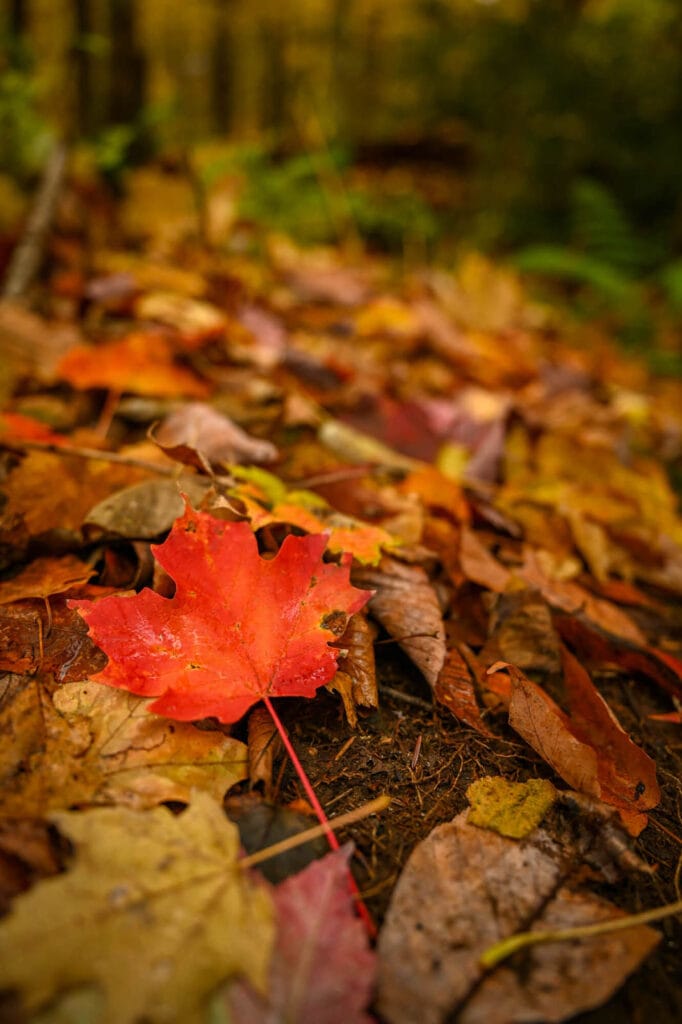
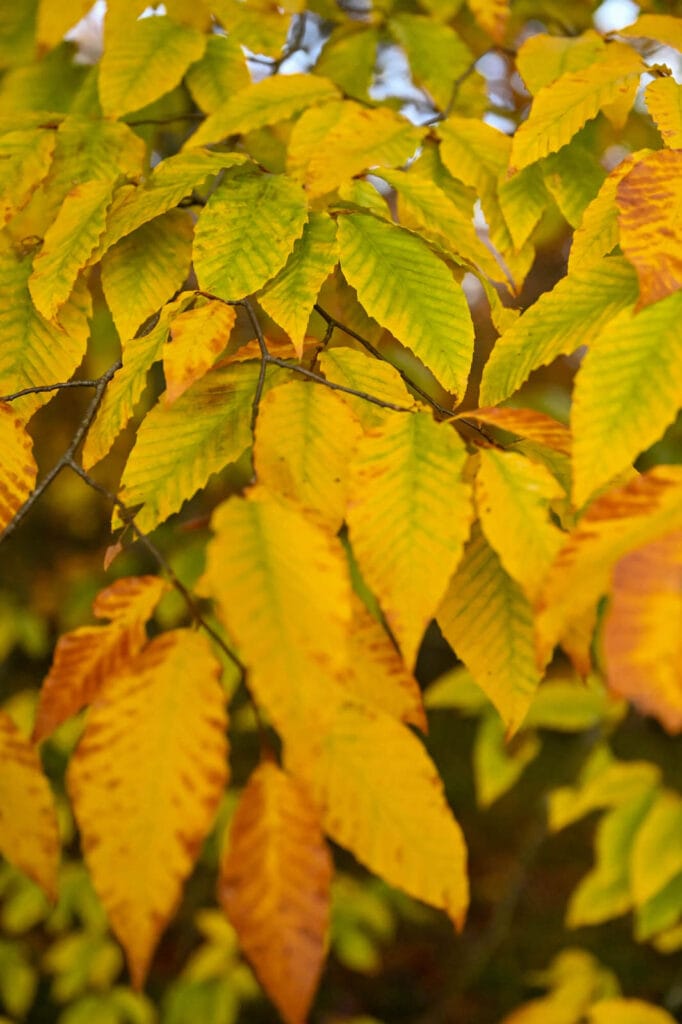
What makes the colors so vivid in the Smoky Mountains?
One reason that fall is so spectacular in the Smoky Mountains is the wide diversity of trees in the park, including over 100 different species. The most beautiful fall foliage is typically found at lower elevations, home to several trees that usually turn the most vibrant colors, including the sugar maple, scarlet oak, sweetgum, red maple, and hickory.
Additionally, over 36% of the Smoky Mountains National Park is covered in old-growth forests, which means the trees are hundreds of years old. What does this mean for fall foliage? These ancient trees and their leaves are enormous, which makes strolling through an old-growth forest in the fall a particularly magical treat!
Lastly, one of the key factors influencing the vibrance of fall foliage is moisture. More moisture tends to produce more vibrant colors. In the Smoky Mountains, there is no shortage of moisture, as precipitation is abundant. In fact, the Smoky Mountains experience the second most rainfall anywhere in the US (the Pacific Northwest takes the top spot!), averaging 55 to 85 inches of rainfall per year.
Tip: For one of the most stunning Old Growth forests in the Smoky Mountains, check out the hike to Ramsey Cascades.
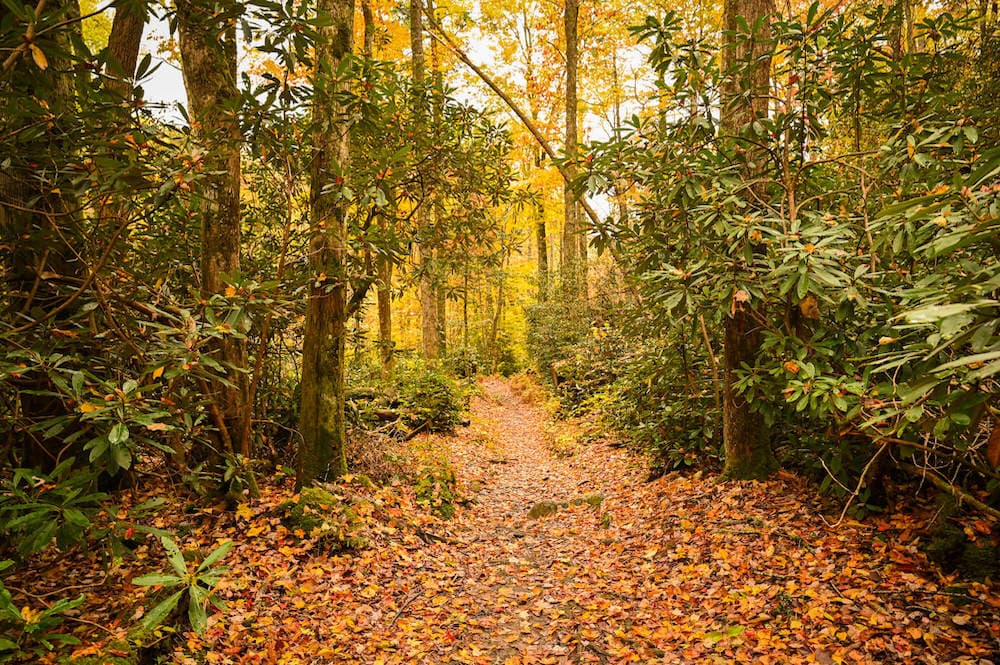
What are the drawbacks to visiting the Smoky Mountains in the fall?
While the beautiful foliage and ideal weather conditions make fall a great time to visit the Smoky Mountains, be prepared to share the views. The Great Smoky Mountains National Park is the most visited national park in the United States, receiving over 12 million visitors per year. Fall is one of the most popular times to visit the park, as visitors flock to the area to experience the stunning Smoky Mountains’ fall colors.
Visiting during early November is one way to experience fall foliage in the Smoky Mountains with fewer crowds. By this time, the higher elevations have passed their peak, but the lower elevations are likely to still put on a show.
Smoky Mountains Fall Weather
Fall weather in the Smoky Mountains is fairly mild with warm days and cool nights. During early fall, daytime temperatures average in the mid-70s, while nighttime temperatures typically drop into the 50s and upper 40s. By early November, daytime temperatures average around the mid-50s, with nighttime lows often dropping below freezing.
September through November is the driest season in the Smoky Mountains, another great reason to visit during the fall! Occasional rain showers are still possible, and at higher elevations, snow is not uncommon by November.
6 Best Smoky Mountains Hikes for Fall Colors
Getting out on the trails is one of the best ways to experience the Smoky Mountains fall foliage! Below, we’ll detail a few awesome hikes for the best foliage-viewing, including the ideal time of year for each (keep in mind that this can vary year to year!).
1. Clingman’s Dome
- Distance: 1.2 miles
- Elevation Gain: 300 feet
- Difficulty: Moderate
- Peak Elevation: 6,643 feet
- Best month for fall foliage: September
Clingman’s Dome is a circular viewing platform located at the tallest point in the Smoky Mountains, with striking views in every direction. Despite its high elevation, Clingman’s Dome is easily accessible via a half-mile paved (but steep) trail. For a longer hike, you can first descend to Andrews Bald from the parking area and then continue up to Clingman’s Dome, for a 4.5-mile round trip hike.
Clingman’s Dome sits at an elevation of 6,643 feet, meaning the leaves begin to change here first. For the best fall colors, we’d recommend visiting Clingman’s Dome in September, although it’s certainly still beautiful even after the leaves have fallen.
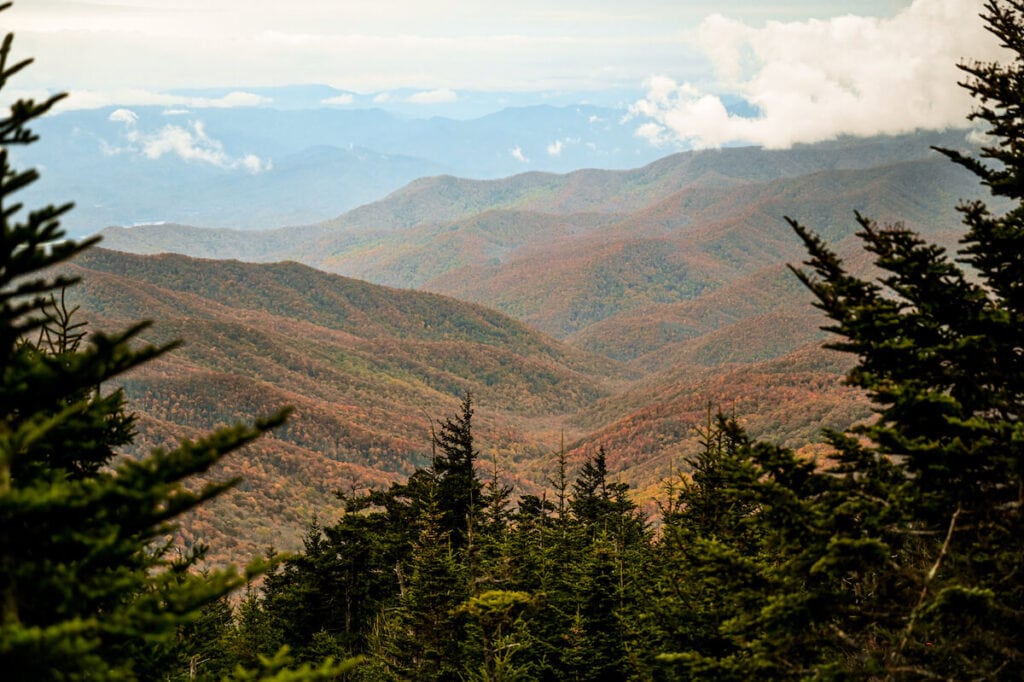
2. Mount LeConte
- Distance: 11 miles
- Elevation Gain: 2,900 feet
- Difficulty: Hard
- Peak Elevation: 6,593 feet
- Best month for fall foliage: September
Mount LeConte is the third tallest peak in the Smokies and the summit features stunning views of the rolling mountains below. Reaching the summit is no easy feat, however, as the trail gains nearly 3,000 feet over the course of 5.5 miles (11 miles roundtrip). Those willing to put in the effort will be rewarded with beautiful fall colors as you meander along a babbling stream, under a rock arch, and through a cave on your way to the summit.
Due to its higher elevation, you can catch fall colors earlier in the season while hiking to Mount LeConte. For the best fall colors, we’d say September is probably the best time to go.
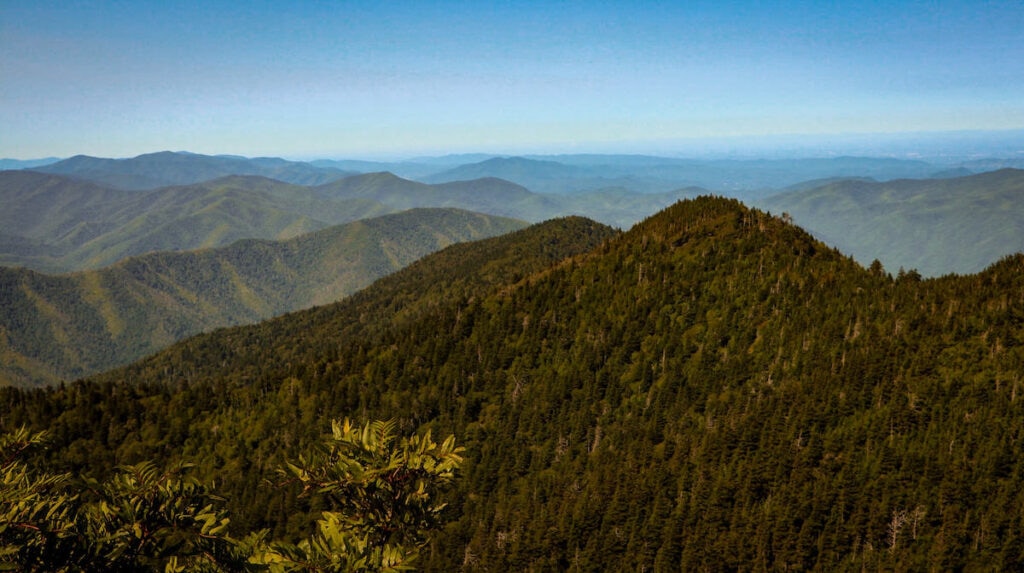
3. Charlies Bunion
- Distance: 8 miles
- Elevation Gain: 1,800 feet
- Difficulty: Moderate
- Peak Elevation: 5,528 feet
- Best month for fall foliage: September to early October
Despite its unappealing name, Charlies Bunion is a lovely rock outcropping with unimpeded Smoky Mountain views in every direction. Clocking in at 8 miles total distance with 1,800 feet of elevation gain, the hike to reach Charlies Bunion is moderately challenging.
Reaching an elevation of 5,528 feet above sea level, Charlies Bunion is a bit lower than Mount LeConte but still fairly high for the area. Given its elevation, the best time to hike Charlies Bunion for fall foliage is typically late September to early October.

4. Mount Cammerer
- Distance: 12 miles
- Elevation Gain: 3,200 feet
- Difficulty: Hard
- Peak Elevation: 4,928 feet
- Best month for fall foliage: mid to late October
Mount Cammerer is located closer to Cosby, TN (and away from the central hub of Gatlinburg, TN), a less popular area of the park that typically sees fewer crowds. The summit of Mount Cammerer features sweeping 360-degree views from an old lookout tower and is one of my personal favorite hikes in the park.
While some may be intimidated by a 12-mile trek with 3,200 feet of elevation gain, don’t forget that the vibrant fall colors will distract you from the strain on your legs as you climb up! Located on the northeastern side of the park, the summit sits at a slightly lower elevation and peak foliage is typically sometime in mid to late October.
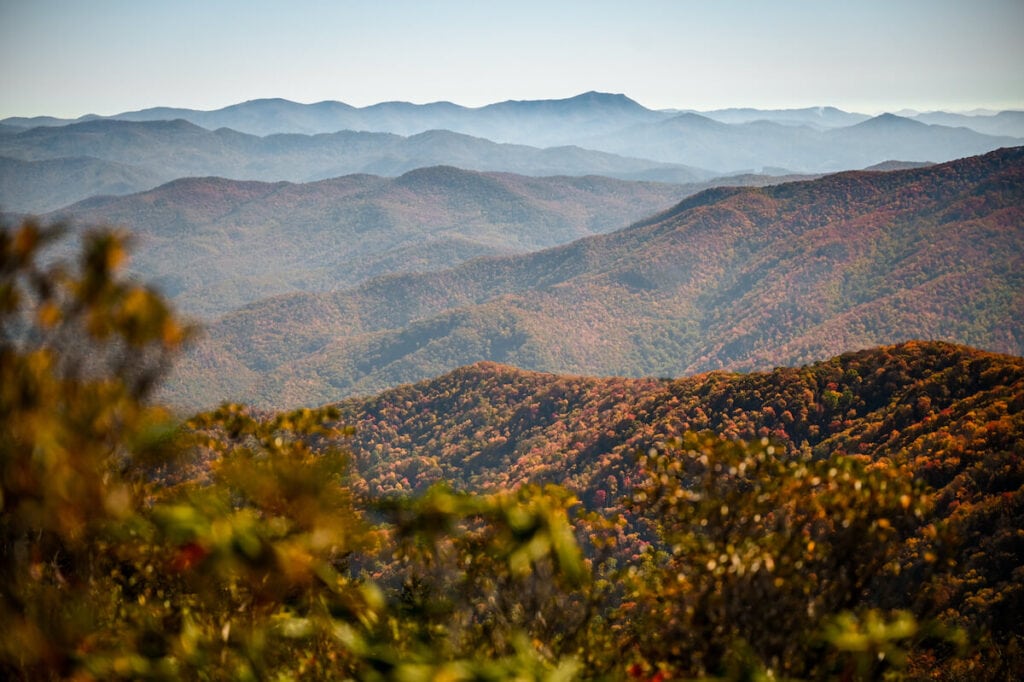
5. Ramsey Cascades
- Distance: 8 miles
- Elevation Gain: 2,225 feet
- Difficulty: Hard
- Peak Elevation: 4,290 feet
- Best month for fall foliage: late October to early November
Did you know that there are over 100 waterfalls in the Smoky Mountains? Cascading 100 feet over a pile of massive boulders, Ramsey Cascades is the tallest, and most magnificent, waterfall in the Great Smoky Mountains National Park. And while the waterfall itself is stunning, the trail to reach it may be even more scenic, as it winds through an enormous old-growth forest containing some of the largest trees you’ve ever seen, perfect for fall foliage!
In terms of elevation, the hike starts around 2,000 feet above sea level and ends at Ramsey Cascades, which sits at 4,200 feet, making it a great hike for later in the fall, from October through early November.
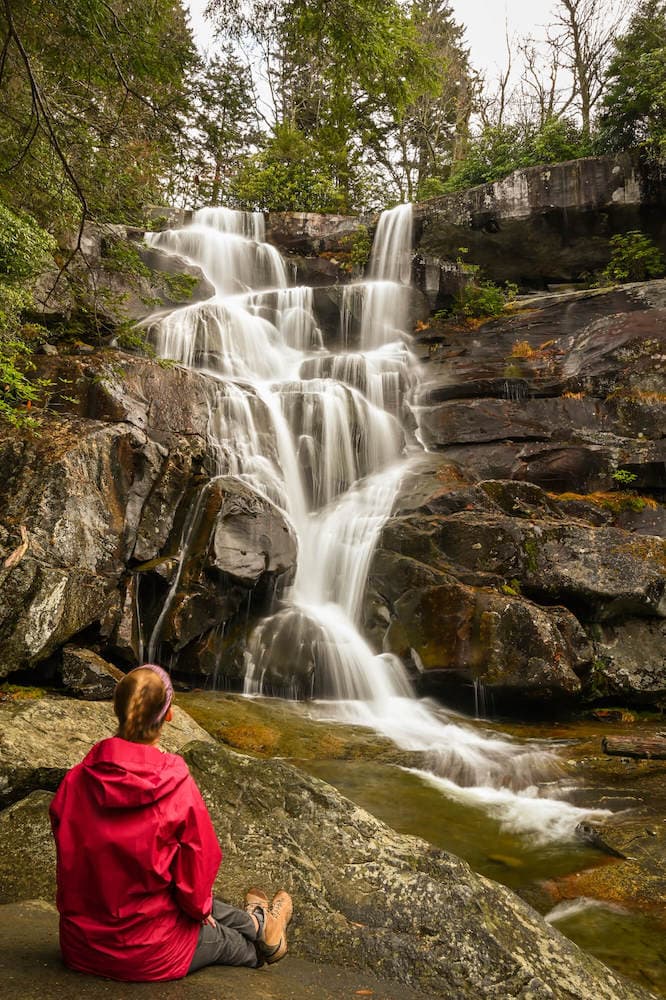

6. Deep Creek Loop
- Distance: 5 miles
- Elevation Gain: 800 feet
- Difficulty: Easy to moderate
- Peak Elevation: 1,800 feet
- Best month for fall foliage: early November
Located on the North Carolina side of the park, the Deep Creek Loop sits at a lower elevation (around 1,800 feet), making it an ideal hike for early November to see the best fall colors. The Deep Creek Loop features 3 waterfalls (Tom Branch Falls, Juney Whank Falls, and Indian Creek Falls) and boasts some of the most colorful foliage in the park.
The full Deep Creek Loop is 5 miles long, but you can shorten it to 2.4 miles by taking a shortcut, which cuts out Indian Creek Falls.

Additional Things to Do in the Smoky Mountains in Fall
Besides the hikes listed above, there are plenty of other ways to experience fall foliage in the Smoky Mountains. Below, we’ve outlined a few more of our favorite things to do in the Smoky Mountains in the fall.
Drive the Cades Cove Scenic Loop
The 11-mile Cades Cove Scenic Loop is one of the best ways to see fall foliage in the Smoky Mountains if you aren’t up for one of the hikes listed above (or need a rest day!). The road loops through an open meadow, passing several historic buildings, and offers the opportunity to enjoy beautiful fall colors from the comfort of your car!
There are several pull-offs and parking areas along the way, which make for the perfect spot to stop and have a picnic. Wildlife sightings, including deer, black bears, turkeys, and coyotes are not uncommon along the way.
Although the Cades Cove Loop is only 11-miles, you should expect the entire drive to take about 2 hours due to slow-moving traffic. Cades Cove is located near Townsend, Tennessee at an elevation of 3,380 feet, making it a great spot to visit during mid to late fall (October through November) in the Smoky Mountains.
Tip: On Wednesdays, the Cades Cove Scenic Loop is closed to vehicle traffic. This is a great time to explore the area by bike!
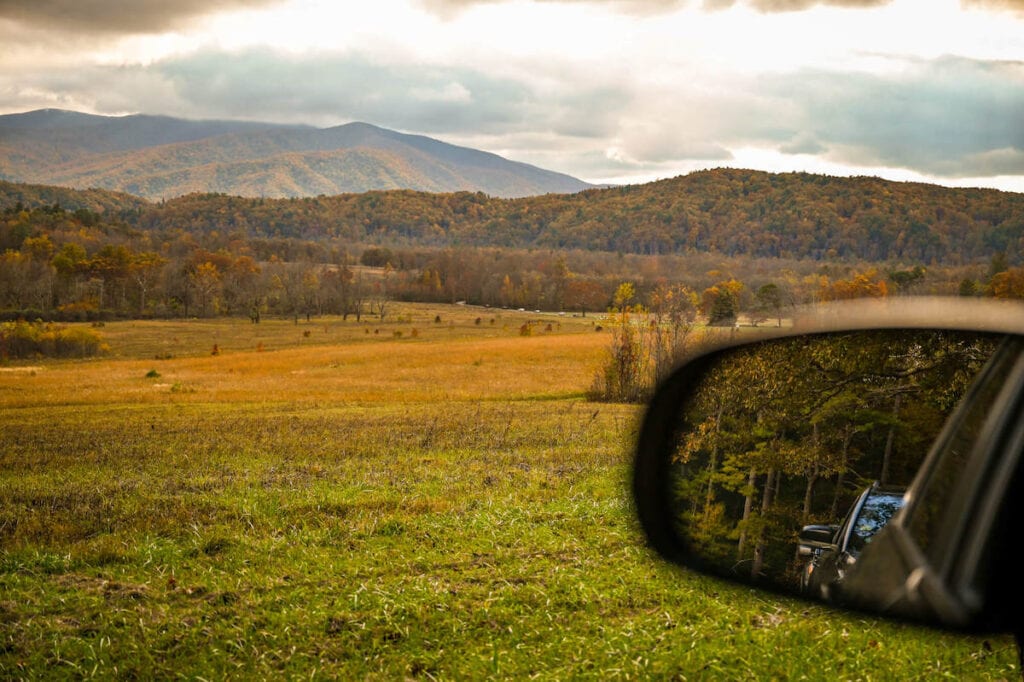
Drive Scenic Newfound Gap Road
Newfound Gap Road, also known as Highway 441, traverses 30 miles through the Smoky Mountains, from Cherokee, North Carolina to Gatlinburg, Tennessee. The road includes some of the best viewpoints in the Smoky Mountains for fall foliage, including:
In addition to incredible viewpoints, the trailheads for several of the best hikes in the park are located off Newfound Gap Road, including Mount LeConte, Charlies Bunion, and Clingman’s Dome.
The drive covers a wide range of elevation so it’s difficult to say when, exactly, is the best time to see fall foliage, but given the change in elevation, you’re bound to see some colors almost anytime throughout the fall.

Go Fishing
Over 2,900 miles of streams flow through the Smoky Mountains, about 20% of which are home to brown, rainbow, and brook trout, making it a prime fishing spot. In fact, the Great Smoky Mountains National Park is one of the last remaining habitats for wild trout on the East Coast! Sitting on the banks of a stream below a canopy of yellow leaves with a fishing rod in hand sounds like a great way to experience fall in the Smoky Mountains.
A North Carolina or Tennessee fishing license is required to fish in the Smoky Mountains. You can find more details about fishing in the Smoky Mountains here.
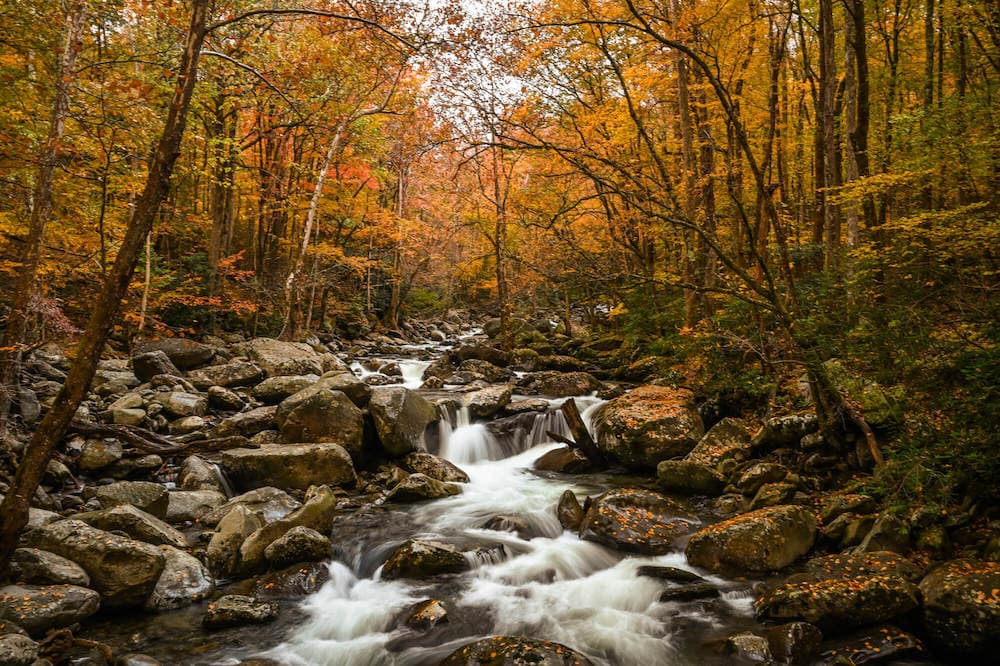
Go on a Backpacking Trip
If you want to escape the inevitable crowds throughout the park, we recommend you load up your pack and hit the trail for an overnight backpacking trip. A few popular backpacking trips include the Mount Cammerer and Mount Sterling Loop (29 miles), Spence Field Loop (12.5 miles), Mount LeConte (11 miles), and the Charlies Bunion – Kephart Loop (16.8 miles).
In addition to leaving some of the crowds behind, spending the night sleeping in the backcountry under the stars gives you the opportunity to experience fall colors during sunset and sunrise, a difficult task if you aren’t spending the night in the woods.
Permits are required for backpacking and reservations can be made in advance online. For more details about backpacking in the Smoky Mountains and to plan your trip, see the NPS website.

Where to Stay in the Smoky Mountains
Camping in the Smoky Mountains
We believe that camping is the best way to get the most out of your time in the Smoky Mountains, as you will be sleeping within the park’s boundaries, making early morning drives to trailheads significantly shorter. Luckily, there are a total of 10 campgrounds throughout the park. Advance reservations are not required but are strongly recommended as sites are in high demand and are often reserved well in advance.
Cades Cove and Smokemont campgrounds are open year-round, while the remaining campgrounds are open seasonally and typically close for the year between late October and late November. If planning a trip later in the fall, be sure to pay attention to the closing dates for each of the campgrounds.
Read more about campgrounds in the Smoky Mountains here.

Smoky Mountains Hotels & Lodging
Because Great Smoky Mountains National Park is so large, the best place to stay depends on which hikes and attractions in the park you are interested in doing.
Gatlinburg, Tennessee is the most popular choice, located just outside of the Smokemount Visitor Center and the park’s main entrance. Alternatively, Cherokee, North Carolina is conveniently located 10 minutes from the Oconaluftee Visitor Center, and Townsend, Tennessee is located near Cades Cove. All three of these towns offer a range of hotels, motels, Airbnbs, and cabins.
Cosby, Tennessee is the closest town to the northeastern section of the park, which includes the Mount Cammerer hike, but there isn’t much in the area, especially in terms of lodging options.
Additional Tips for Planning Your Smoky Mountains Fall Trip
- There is no cell service in most areas of the Smoky Mountains. Download maps and directions using one of your favorite hiking apps before you head into the park.
- Unlike most U.S. National Parks, entrance to the Great Smoky Mountains National Park is completely free!
- Due to heavy crowds, parking at many of the popular trailheads in the park fills up quickly. We recommend getting an early start to avoid waiting for parking spots.
- The Great Smoky Mountains are known for having an abundant black bear population, and they are especially active in the fall. Carry bear spray while hiking and store food in bear-resistant boxes or in the car if you plan to camp.
- There are no gas stations in the park. Remember to fuel up before you head into the park!
- Firewood must be certified heat-treated or purchased inside the park to prevent the spread of pests that can destroy the forests. Do not bring outside firewood with you to the park!

What to Pack for your Smoky Mountains Visit
Here are a few resources to help you pack for your fall adventure to the Smoky Mountains National Park:
- Car Camping Essentials
- Car Camping 101: How to plan, what to pack, & more
- What To Wear Hiking in the Fall
We hope that you fall in love with fall in the Smoky Mountains as much as we have! Questions about planning your trip? Leave us a comment below!

